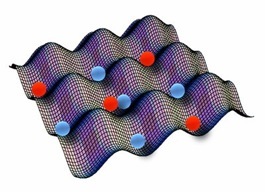Atomic fermions, such as Li6 or K40, in periodic potentials of an optical lattice can be used to understand various aspects of the physics of solids since they can mimic the behavior of strongly correlated electrons in a clean and controllable fashion.


Breakdown of superflow via charge modulational dynamical instabilities
. R. Ganesh, A. Paramekanti, A. A. Burkov, Phys. Rev. A 80, 043612 (2009)
. A. A. Burkov and A. Paramekanti, Phys. Rev. Lett. 100, 255301 (2008)
BCS-BEC crossover of Dirac fermions
. E. Zhao and A. Paramekanti, Phys. Rev. Lett. 97, 230404 (2006)
Detectable Signatures of Ferromagnetism in Repulsive Atomic Fermi Gases
. L. LeBlanc, J. H. Thywissen, A. A. Burkov, A. Paramekanti, Phys. Rev. A 80, 013607 (2009)
Superfluid to Band Insulator Transition in an Optical Lattice
. A. A. Burkov and A. Paramekanti , Phys. Rev. A 79, 043626 (2009)
Pair Density Wave Supersolidity of Atomic Fermions in an Optical Lattice
. P. Nikolic, A. A. Burkov, A. Paramekanti, PRB 81, 015204 (2010)
Motivated by this, we have studied a number of issues in two component atomic Fermi gases --- BCS to BEC crossover of Dirac fermions, superfluid insulator transition induced by the lattice potential, breakdown of superfluidity via competing charge orders induced by a current, pair density wave supersolidity, and signatures of possible ferromagnetism arising from repulsive contact interactions. Some of this is in collaboration with my student Ganesh.